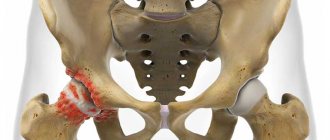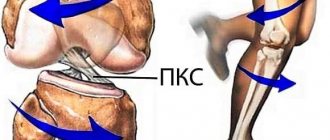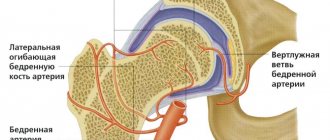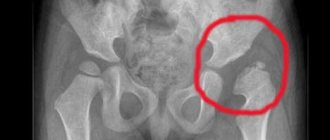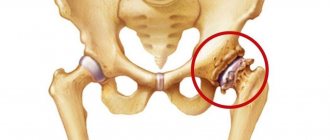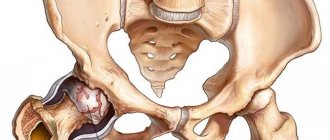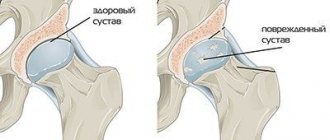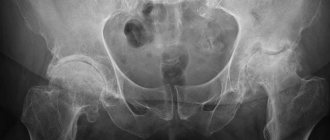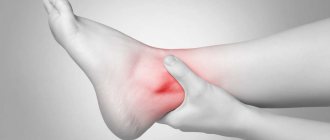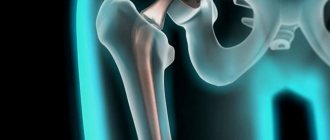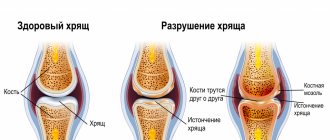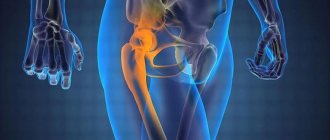Scientists believe that any pathological changes in the functioning of the musculoskeletal system are people’s retribution for walking upright. Throughout life, our body experiences enormous stress, as a result of which ligaments, tendons and cartilage suffer. When joints are healthy, they operate smoothly and silently . But sometimes during movement there is a crunching sound in the bone joints, especially large ones. In most cases, it is accompanied by discomfort and pain. Why does the hip joint crunch, what to do about it - such questions are of great concern to those suffering.
Factors provocateurs
There are many reasons for crunching when walking or the slightest movements of the leg. This may be due to an old, untreated injury or structural changes in cartilage tissue. The hip joint has a complex structure. If its functions are impaired, then serious difficulties with walking arise.
The problem cannot be ignored. If you find a constantly recurring crunch in the hip joint, contact a specialist and undergo a full examination to identify the root cause of the disease. Complex treatment will help get rid of the symptom and restore the normal functioning of the musculoskeletal system.
If you do nothing, pain and limited mobility will eventually join the crunch. If there is significant damage to the components of the joint, there is a need for its complete replacement.
Endoprosthetics operations are highly effective and allow the patient to return their former full life, but the prosthesis itself is expensive. If there is an opportunity to start treatment at an early stage of the disease, it should be taken advantage of. This way you will save yourself money and time.
Causes of crunching in the hip joint
If your hip joint crunches when walking, there can be many reasons for this phenomenon:
Osteochondrosis of the hip joint;- Lack of joint fluid;
- Excessive deposition of salts in the thickness of cartilage tissue;
- Degenerative changes in the structure of bone, cartilage, connective tissue;
- Coxarthrosis;
- Irregular shape of the components of the joint;
- Excessive friction of the head of the joint against its cup.
At the initial stage of any of the above diseases, the crunching inside the joint is not accompanied by noticeable pain. Often the unpleasant sound is not heard when walking, but occurs during physical activity - training in the gym, running, fitness. Over time, other, more serious ones are added to this symptom.
It will not be possible to tolerate them for a long time and neglect them. But if you consult a doctor when pain joins the crunch, the treatment will be long and complicated.
Experienced doctors strive to do everything possible to restore the integrity of the organ using conservative methods and not resort to surgical intervention, but this is not always realistic.
Types of pathologies
A characteristic sign does not always indicate a problem. Clicking sounds can occur due to the accumulation of air bubbles in the synovial fluid, during excessive exercise or due to stress. However, if they worsen the quality of life, continue for a long time and are accompanied by other signs, then the person needs the help of a specialist.
To understand why the hip joint crunches, it is necessary to carefully examine the symptoms of the pathology and determine its type. Even if this is the only visible sign of pathology, examination may reveal accompanying symptoms, allowing a correct diagnosis to be made and treatment to begin.
Iliopsoas syndrome
The iliopsoas muscle is the most common cause of clicking joints. This is explained by the tendon jumping over the acetabular labrum and femoral head during excessive and intense physical activity. At first, sounds characteristic of the problem occur rarely, but as the disorder progresses, their frequency increases and becomes almost constant. Gradually, other signs join the characteristic crunch:
- dull pain in the groin when flexing and straightening the limbs;
- feeling of resistance in the joint;
- joint weakness.
A special test is performed for diagnosis. This muscle is loaded with various sets of exercises. If characteristic sounds occur during their execution, the patient’s diagnosis is confirmed.
Systematic friction of the ligaments can cause iliopectineal bursitis, which significantly complicates the patient’s condition.
Iliotibial band syndrome
If the hip joint crunches, a possible cause is increased friction in the iliotibial fascia. This type of pathology is most common in athletes whose occupation is associated with intense mobility of the limbs. Characteristic sounds are accompanied by pain on the outside of the joint. Possible complications include trochanteritis, an inflammatory process that develops in the trochanteric bursa. It is characterized by increased pain in the periarticular area, redness of the tissues and their swelling.
Acetabular labral tear
The cartilaginous lip is involved in stabilizing the hip joint. Violation of its integrity occurs due to injury or degenerative changes in the structure of tissues. The rupture is characterized by:
- pain in the groin area or above;
- characteristic sounds when moving;
- impaired mobility;
- feeling of resistance in the joint.
For diagnosis, the patient is subjected to a special test with physical stress on the joints of the bones. Pathology is indicated by the appearance of a painful crunch.
Osteoarthritis
Degenerative changes in the structure of cartilage and ligaments often cause a person to have cracking hip joints. One of the pathologies is osteoarthritis of the hip joint. It is more often diagnosed in the male half of the population, since they are more susceptible to heavy physical activity and sports. The following signs indicate the disease:
- restriction of mobility in the problem area;
- sensation of joint friction;
- “starting” pain syndrome (when the first steps after a long period of rest are difficult);
- visible deformation of the bone connection (in advanced forms).
Pain occurs not only while walking, but when supporting the damaged tendon. If the disease has become advanced, the feeling of discomfort persists even at rest. If left untreated, the patient faces disability.
Osteochondropathy
If a crunch occurs in the hip joint in a child, then it can be assumed that he has Perthes disease or osteochondropathy. Usually occurs in children under 12 years of age. The essence of the pathology is necrotic processes of the femoral head, accompanied by the following symptoms:
- pain syndrome;
- fatigue when walking;
- limited limb mobility;
- limping gait;
- shortening of one leg.
Without treatment, the disease progresses rapidly and leads to deforming osteoarthritis.
Mechanical damage
Joint injuries occupy a wide niche in the development of pathological disorders in humans. A characteristic crunch can accompany sprains and ruptures of ligaments and tendons, dislocations, fractures, and bruises. The patient experiences pain of varying degrees of intensity depending on the type of injury received, swelling and swelling of soft tissues, bruising, and limited mobility.
Hip dysplasia
This type of joint pathology is more typical for newborns and is diagnosed by an orthopedist in the patient’s infancy. If left untreated at a later age, the crunching and clicking sounds are accompanied by lameness, “duck gait,” a feeling of heaviness, fatigue in the hip, and instability of the joint. In the future, dysplasia can develop into coxarthrosis.
For any functional disorders accompanied by a crunch of the hip joint, differential diagnosis is necessary.
Crunching and pain in the hip also occur with other diseases: intervertebral hernia, cartilage tear, fracture of the pelvic bones or femoral neck, osteoperiostitis of the pubic bone and others.
Why is a crunch in a joint dangerous?
At first, extraneous sounds in the hip joint when walking do not cause any inconvenience, but over time the problem worsens. A crunch means that the structure of the joint is disturbed, something is preventing it from functioning normally. Due to excessive friction of the bone tissue, the organ is destroyed. It can only be restored through a complex operation.
Some people consider it normal if, over the age of 30-35, their knees and hip joints crack. They attribute this to salt deposits and do not see anything serious about the problem. The reality is that because of such a symptom, you can remain deeply disabled without the ability to move independently. This is the main danger of crunching.
This symptom should not be neglected. You cannot be treated by charlatans. In recent years, recovery sessions with chiropractors and osteopaths have gained popularity.
Osteochondrosis of the hip joint
The most common diagnosis in patients who complain of a crunch in the hip joint is osteochondrosis. The cartilage tissue underlying the joint changes its structure with age due to excessive load, salt deposits, and lack of fluid in the body. Inflammation occurs around the joint, and the roots of the nerve endings located nearby are pinched. At first, the leg simply crunches when walking or moving the hip to the side.
Over time, this symptom is accompanied by pain. It is so strong that the patient cannot get out of bed in the morning and walk normally. He has to “pace” through the discomfort. Only after this can he walk normally.
Over time, lameness joins the pain and crunching. Then sensation in the leg is lost. This is due to the death of pinched nerve endings. Such fibers cannot be restored. You'll have to live with this problem.
Such a development of the disease is traditional in the absence of treatment. If you consult a doctor in a timely manner and get examined, he will prescribe a number of drugs that help restore the tissue structure. Drug treatment together with physiotherapy gives a quick positive result.
The examination begins with an examination by a specialist and special functional tests. Already now the doctor can draw certain conclusions, but to make an accurate diagnosis, other diagnostic methods are also used - X-rays, MRI, CT. In rare cases, an ultrasound of the hip joint is prescribed.
After a certain time after the start of treatment, the examination is repeated so that the specialist evaluates the positive dynamics or adjusts the treatment methods used.
Alarming symptoms
If a person has the following symptoms, you need to quickly find out the cause by conducting a full examination:
- there is swelling or redness in the pelvic area;
- a click occurs with certain movements, before it there is a feeling of discomfort that goes away after the crunch;
- after sleep or prolonged sitting, it takes time for the joints to gain mobility and recover;
- pain and other unpleasant sensations - numbness of the limbs, poor joint mobility;
- increased body temperature;
- exacerbation of concomitant diseases, for example, the thyroid gland or diabetes.
The patient's medical history usually contains pathologies that were identified in childhood - dysplasia, injuries, dislocations during childbirth, calcium metabolism disorders.
Impingement syndrome of the hip joint
Another prerequisite for the appearance of a crunch in the hip joint is impingement syndrome. This disease develops against the background of congenital or acquired pathologies. The shape, size and location of the joint parts are different from the standard. Due to developmental anomalies, excessive friction of the joint head against the acetabulum occurs, which is why a crunching sound is heard.
Chronic trauma to the hip joint eventually leads to its complete destruction. This problem is mostly treated surgically. If, with timely detection of the disease, it is possible to get by with a simple minimally invasive operation using arthroscopy, then over time it is not possible to perform restorative intervention.
The only option left is organ replacement surgery. Joint replacement is a complex process that requires considerable preliminary preparation and long recovery. It can be avoided if conservative treatment is started in a timely manner.
First, the doctor determines the type of pathology, then makes a decision regarding the method of influence on the body.
The dynamics are monitored throughout the entire treatment period, positive measurements are noted. Over time, the patient returns to a full life. All this becomes possible when undergoing treatment from experienced doctors.
Classification of pathological disorders
Clicking and crunching sounds in the thigh are classified depending on the location of the problem:
- outer . The sound characteristic of pathology occurs in the outer part of the femoral diarthrosis due to the jumping off of the connective fascia when moving from the greater trochanter of the femur. Having undergone systematic blows, the joint capsule becomes inflamed, and the patient develops bursitis;
- intra-articular . This species is characterized by disturbances inside the diarthrosis cavity. As a result of deterioration in the sliding of the head along the acetabulum, it jumps off, making a sound similar to a click. An example of an intra-articular pathology is congenital dysplasia;
- internal . The mechanism of the crunch is caused by the rolling of the iliopsoas muscle through the head of the femoral bone. If left untreated, the risk of bursitis complications increases significantly.
Hip injuries
Crunching in the hip joint often develops after injury. It happens that a person fell on his side, was seriously hurt, but refused to visit the emergency room. After a few days, the pain subsided, the hematoma went away, and a month later a crunch appeared in the leg. In this way, the body signals the consequences of injury.
A bruise, dislocation, subluxation, crack in a bone, and even a fracture may not be accompanied by pain for some time. Only after a while does the patient learn about the consequences of the injury, when they have already become irreversible.
To avoid this, after a fall or a strong blow, it is advisable to contact a traumatologist, take an x-ray and assess the consequences of the injury. The doctor will prescribe healing medications. If you follow these recommendations, crunching will not appear in the future.
How to help the body?
A person can help his own joint by going to a medical facility and undergoing an examination. Further treatment will be selected depending on the pathology. If the crunch is accompanied by pain, measures will be taken to eliminate it.
If the problem is not a disease, most likely the doctor will advise you to resort to disease prevention and strengthening of ligaments and muscles. The rules will be:
- Physical activity should not be long and alternate with rest.
- You should give up passive pastime. Regular walks in the park or cycling will do.
- Switch to proper nutrition. Minimize the amount of salty, fried and sweet foods; it is recommended to indulge in vegetables and fruits, dairy products.
- It is necessary to carry out daily exercises, and it is best to use a hip orthosis.
Athletes and amateurs are advised to warm up well before exercise - self-massage with essential oils or warming ointments.
An involuntary crunch in any joint is an alarming symptom. Since the hip joint is most susceptible to various problems, and treatment is always long, vigilance is required. Those people who are attentive to their own health and the health of their children always have fewer problems.
Prevention methods
To prevent the development of a crunch in the hip joint, you need to follow simple tips:
- To live an active lifestyle;
- Walk a lot;
- Monitor your weight;
- Use the principles of rational healthy nutrition;
- Exercise;
- Contact a doctor promptly if you notice any unpleasant symptoms.
If you take care of your health and do not neglect the advice of specialists, then you will be able to maintain health and the integrity of your joints into old age.
Which doctor should I contact with this problem?
Some patients do not know which specialist to contact with the problem of crunching in the hip joint. It is advisable to visit your GP first. He will conduct an examination and send you to a traumatologist or neurologist. Sometimes a rheumatologist is involved in the treatment process.
If a patient requires hospital treatment or surgery, doctors immediately warn about this. try to contact experienced professionals who can quickly help solve problems that arise.
